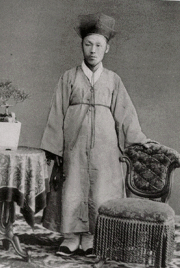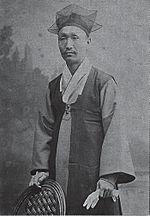Kim Ok-gyun facts for kids
| Kim Ok-gyun | |
| Hangul |
김옥균
|
|---|---|
| Hanja |
金玉均
|
| Revised Romanization | Gim Ok-gyun |
| McCune–Reischauer | Kim Okkyun |
| Art name | |
| Hangul |
고균, 고우
|
| Hanja |
古筠, 古愚
|
| Revised Romanization | Gogyun, Gou |
| McCune–Reischauer | Kogyun, Kou |
Kim Ok-gyun (born February 23, 1851 – died March 28, 1894) was an important leader in Korea during the late Joseon dynasty. He was a "reformist," meaning he wanted to change and improve his country. Kim Ok-gyun worked for King Gojong and tried to bring new ideas and technologies from Western countries to Korea.
His main goal was to help Korea become strong and modern. He believed that by learning from other countries, Korea could protect itself from outside threats. Kim Ok-gyun was killed in Shanghai, China. After his death, he was given the special title "Chungdal."
Contents
Early Life of Kim Ok-gyun
Kim Ok-gyun was born on February 23, 1851, in a place called Chungcheongnam-do. His family, the Andong Kim clan, was not wealthy. When he was four, his family moved to Cheonan. His father ran a small school called a Seodang, where Kim Ok-gyun received his early education.
When he was six, Kim Ok-gyun was adopted by a distant relative, Kim Byung-gi. This was because Kim Byung-gi had lost his own son and wanted to continue his family name. For a few years, Kim Ok-gyun lived in what is now Seoul. In 1861, his adoptive father became a governor, and they moved to Gangneung.
Later, when Kim Ok-gyun was fifteen, his adoptive father got a job in the judicial office. They moved back to Seoul. There, Kim Ok-gyun met and competed with other young people from important families. He was very talented in music, singing, dancing, poetry, and art. His skills were so well-known that even the Queen Dowager invited him to the palace.
At age 22, Kim Ok-gyun took a very difficult national exam to work for the government. He passed with a high score, which usually took many years to achieve. To protect his adopted son from political problems, Kim Byung-gi decided to retire from his job.
Kim Ok-gyun's Efforts to Change Korea
During Kim Ok-gyun's time, Korea was changing. The country had tried to avoid contact with Western countries for a long time. But now, trade with the West was starting, and new foreign policies were being made. Kim Ok-gyun believed Korea needed to open up and modernize to survive.
The Independence Party
Kim Ok-gyun found many people who agreed with his ideas about opening up Korea. They formed a group called the Dongnipdang, which means "Independence Party." They wanted Korea to learn from Western countries and adopt their knowledge and technology.
This group even met a Buddhist monk who showed them a special European device. It was a projector that showed pictures of places like London and a Portuguese soldier. The monk also had a Japanese book with scenes from other countries. The activists asked the monk to bring them more Western items, which had to be kept secret because of the strict rules against foreign contact.
First Plan: Learning from Japan
After a conflict with the Imperial Japanese Navy, Korea signed the Treaty of Ganghwa. Kim Ok-gyun was against this treaty. He realized that Japan, which Korea had once seen as less advanced, had modernized and become very strong.
So, in 1881, Kim Ok-gyun got permission to visit Japan. He wanted to learn how Japan had modernized so quickly. In Tokyo, he met important Japanese politicians. He even studied at Keio University. Kim Ok-gyun decided that Korea needed Japan's help to modernize, especially since China was becoming weaker.
He asked for financial help from a Japanese statesman named Inoue Kaoru. Inoue promised him money if Kim could get permission from the Korean King for reforms. But this promise was broken due to other political issues. Kim Ok-gyun returned to Korea in 1884 without the help he needed.
Second Plan: The Gapsin Coup
Kim Ok-gyun and his group, the Gaehwapa, continued to meet and discuss world events. They saw that Japan was trying to gain more influence in Korea, especially during the Sino-French War.
Kim Ok-gyun secretly visited the Japanese embassy. He learned that Japan still supported his reform movement. The Japanese officials told him that the Sino-French War was a good chance for a new movement in Korea, and Japan would help.
Kim Ok-gyun then planned a revolution with his group and Japanese supporters. Their plan involved causing a big disturbance during the opening of a new postal service office. They would use explosives and gunshots to create chaos. During this confusion, they would remove certain political figures from power. The Japanese embassy promised military support for this plan. Young leaders like Seo Jae-pil and Seo Gwang-beom also supported Kim's efforts.
On the night of December 4, 1884, a fire started near the post office reception. As planned, the activists caused chaos. They took control of the government, and this event became known as the Gapsin Coup.
Chinese Involvement and Kim Ok-gyun's Death
The details of the Gapsin Coup soon became known to Queen Min (later known as Empress Myeongseong). She felt her power was threatened. So, the Queen secretly asked the Chinese military for help.
Korean and Japanese soldiers fought against the Chinese army, but they were outnumbered and had to retreat. The Chinese army's strength meant that Kim Ok-gyun's group lost power. Their lives were in danger.
Kim Ok-gyun and other activists fled to the city port of Jemulpo (Incheon). They boarded a Japanese ship. When there was a demand to hand them over, the Japanese captain refused. Many activists went to the United States, but Kim Ok-gyun went to Japan. He lived under the protection of the Japanese government, using a new name, Iwata Shusaku. He stayed in Tokyo, Sapporo, and even visited the Ogasawara Islands.
Kim Ok-gyun lived in fear of being killed after the coup failed. However, he was invited to meet with a powerful Chinese official, Li Hongzhang, in Shanghai. Kim felt he could not refuse this invitation. Before leaving, he gave his personal diaries to a close Japanese friend, just in case something happened to him.
A man named Hong Jong-u, who had traveled to Japan to kill Kim Ok-gyun, learned about the trip. He managed to get on the same ship to China. While on the way to Shanghai, Hong Jong-u killed Kim Ok-gyun with a pistol. Hong later returned to Korea and was given an important job.
In Japan, a memorial service was held for Kim Ok-gyun, and a gravestone was placed for him in the Aoyama Cemetery in Tokyo. The killing of Kim Ok-gyun was one of the reasons Japan later started the First Sino-Japanese War.
After Kim Ok-gyun's Death
Kim Ok-gyun's assassination was a major event that helped lead to the First Sino-Japanese War. This war changed the power balance in East Asia.
Popular Culture
- Portrayed by Yoo Tae-woong in the 2010 SBS TV series Jejungwon.
- Portrayed by Yoon Hee-seok in the 2014 KBS TV series Gunman in Joseon.




